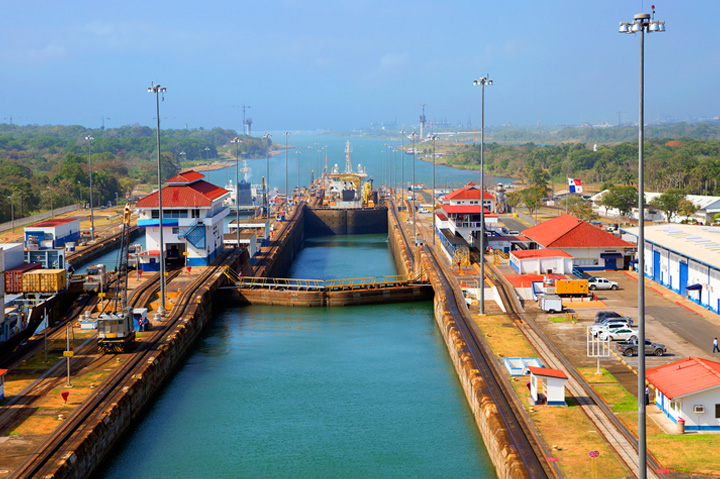News November 06, 2023
Industry Suppliers Navigating Panama Canal Sourcing Challenge
Drought-caused issues are making it more difficult to move products coming from Asia through the waterway, but suppliers say impacts to their operations have so far been minimal and they’re adapting.
Worsening drought conditions are complicating cargo ships’ efforts to pass through the Panama Canal and reach East Coast U.S. ports, a supply chain challenge that leaders in the promotional products industry say so far hasn’t significantly inhibited the in-flow of inventory from abroad.

One of the locks that allow ships to pass through the Panama Canal.
The Situation at the Canal
Last week, the Panama Canal Authority announced that it’s further reducing the number of ships it allows to pass through the canal daily from an already-lessened 29 to 25. Over the next several months, further reduction will occur, until only 18 per day are allowed to pass in February, the authority said. Normally, 34 to 36 ships pass each day.
It’s all a result of a rampant El Nino weather pattern that’s caused a drought. The lack of rain matters because the right amount of water is needed to enable ships to pass through the canal’s system of locks. Without adequate water, vessels can’t transit through in as great of numbers as normal.
This is how the Panama Canal works 🚢 pic.twitter.com/69OYWksuWA
— Learn Something (@cooltechtipz) August 18, 2023
That can prove an issue for U.S.-based importers, including those in promo.
Located in Panama, a nation at the southern tip of Central America, the canal allows ships to pass from the Pacific Ocean into the Atlantic Ocean – and vice versa. It’s generally considered the most efficient way to move cargo by ship from certain key overseas manufacturing nations in Asia, like China and Taiwan, to the U.S. East Coast and Gulf Coast. Most promo products sold in North America are made in China and other Asian nations.
The reduced capacity at the canal is already resulting in it taking longer for ships to reach certain major East Coast ports, including Charleston, Savannah and New York, according to shipping authorities. MarineTraffic said that wait times for ships on the Pacific side of the canal – vessels that would be coming from Asia – has extended to 2.2 days.
About $270 billion of cargo moves through the Panama Canal annually. The Panama Canal accounts for 46% of the total market share of cargo containers moving from Northeast Asia to the East Coast of the United States, according to the U.S. Department of Commerce.
‘We Don’t Anticipate Issues Getting Inventory’
While promo sourcing leaders who ship product from overseas to the East Coast are paying close attention to developments at the Panama Canal, they told ASI Media that there have been minimal impacts to operations so far – and they have contingency plans.
Jing Rong, vice president of supply chain at Massachusetts-headquartered Top 40 supplier HPG (asi/61966), said that ships bearing containers have been given a priority to pass and there’s been fairly negligible delays for HPG’s shipping partners to get through. She noted that draft restrictions from the low water level have reduced vessels’ loading capacity by about 10%, but that’s not led to issues for the supplier.
“Most companies in our industry, including us, have plenty of inventory on hand,” said Rong. “We’re accounting for the possibilities of delays in product arrival at East Coast ports by adding a few additional weeks in our transit time.”
“We’re planning on elongated ocean cargo time of 10 days, and booking our sailings to account for that.” Jeffrey Nanus, AAA Innovations (asi/30023)
Matt Cook, chief operating officer at Florida-headquartered Top 40 supplier Koozie Group (asi/40480), told ASI Media that the firm has been in close contact with its global logistics partners about the Panama Canal. So far, so good, Cook said.
“Carriers are still making appointments and sailing accordingly,” Cook said. “If anything, we may start to see blank sailings, however, nothing has been announced yet. Everyone is anticipating a problem before anything has been interrupted. Ultimately, we don’t anticipate any issues getting inventory in a timely fashion.”
Cook noted that, if the situation really deteriorated, shipments could be routed to West Coast ports. Truck and rail providers would then carry the products to eastern warehouses for – a less efficient and costlier alternative but a viable one.
Meanwhile, suppliers could also have East Coast/Gulf Coast-bound cargo transported by ship from Asia through the Suez Canal, an artificial sea-level waterway in Egypt, and then on to North America. Under normal conditions, that route takes a few days longer than bringing products from Asia to the eastern U.S. than going through the Panama Canal but is still a solid option.
“The extra money and time traveling through the Suez may add a week to 10 days for cargo to arrive,” Alan Baer, CEO of shipping solutions provider OL USA, told CNBC.
Jeffrey Nanus told ASI Media that to date AAA Innovations (asi/30023) has been fortunate. The New Jersey-based supplier of eco-friendly hard goods’ product-filled containers coming through the Panama Canal have been arriving on time. Still, Nanus is taking steps to help ensure that continues.
“We’re planning on elongated ocean cargo time of 10 days, and booking our sailings to account for that,” he said.
The issues at the Panama Canal could further drive a phenomenon already underway in the shipping world – namely, increasing cargo arriving at U.S. West Coast ports. During contentious labor negotiations on the West Coast docks, importers worried about delays and work stoppages shifted some of their shipments to East Coast destinations. But since the labor situation was settled, there’s been a notable flow back to the Pacific.
